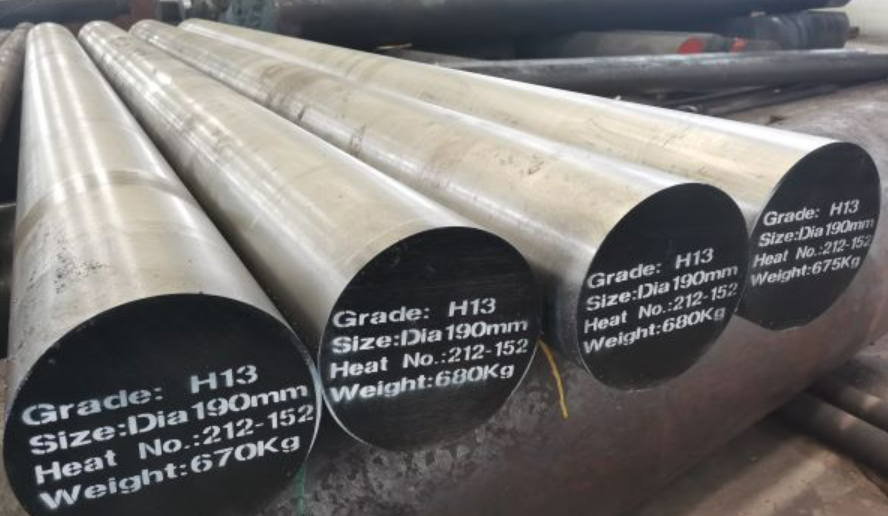H13 tool steel is a high-quality steel widely used in tool manufacturing. It is known for its excellent wear resistance, toughness, and heat resistance, making it ideal in the manufacture of tools that need to withstand high intensity and prolonged use. The composition of H13 tool steel mainly includes elements such as iron, carbon, chromium, tungsten, and vanadium. These elements, after appropriate heat treatment, can give the steel the required hardness and toughness. In this article, we will introduce in detail the composition, properties, and uses of H13 tool steel.

Composition, Properties, and Uses of H13 Tool Steel:
H13 Tool Steel – 1. Composition:
- C 0.32~0.45,
- Si 0.80~1.20,
- Mn 0.20~0.50,
- Cr 4.75~5.50,
- Mo 1.10~1.75,
- V 0.80~1.20,
- p ≤ 0.030,
- S ≤ 0.030
H13 Tool Steel – 2. Properties:
As an electroslag remelting steel, it has high quenching, and penetration, and heat crack resistance. This steel contains a higher carbon and vanadium content, good wear resistance, relatively weak toughness, good heat resistance, good strength and hardness at higher temperatures, high wear resistance, good comprehensive mechanical properties, and high anti-rebound stability.
H13 Tool Steel – 3. Uses:
H13 tool steel is widely used in the following fields:
- Mold Making: Due to its excellent wear resistance, toughness, and heat resistance, H13 tool steel is ideal for manufacturing tools and molds that withstand high intensity and prolonged use.
- Hot extrusion die: A die used to extrude metal at high temperatures. Precision forging die: A die used for precise plastic forming of metal.
- Die Casting Mold: A mold used to inject molten metal into a mold to form metal parts of a specific shape and size.
- Cutting tools: Due to its high hardness and wear resistance, H13 tool steel is also commonly used in the manufacture of cutting tools, such as drill bits, milling cutters, etc.
- Mechanical parts: Due to its excellent comprehensive mechanical properties and heat resistance, H13 tool steel is also often used to manufacture mechanical parts that need to withstand high loads and high temperatures.
In summary, H13 tool steel is a high-quality, high-performance steel that is widely used in various tool and mold manufacturing fields.
H13 steel thermal treatment process:
- Preheat treatment
The H13 steel materials and dies supplied by the market have been annealed by the steel mill to ensure good metallographic structure, appropriate hardness, good processability, and no need for further annealing. However, after the re-forging operation by the manufacturer, the original structure and properties are destroyed, and the forging stress is increased, so it is necessary to re-anneal.
Isothermal ball annealing process: heating to 860~890℃ for 2h, cooling to 740~760℃ for 4h, then cooling to 500℃ and out-off furnace.
- Quenching and tempering
If the die is required to have good toughness, the quenching process specification is as follows: heating temperature 1020~1050℃, oil or air cooling, hardness 54~58HRC. If the die is required to have heat resistance, the quenching process specification is as follows: heating temperature 1050~1080℃, oil cooling, hardness 56~58HRC.
Recommended tempering temperature: 530~560℃, hardness 48~52HRC; tempering temperature 560~580℃, hardness 47~49HRC.
The tempering should be carried out twice. When tempering at 500℃, there is a secondary hardening peak of tempering, and the hardness reaches the maximum value of about 55HRC, but the toughness is the worst. Therefore, it is better to avoid tempering at about 500℃. It is recommended that tempering should be carried out within the range of 540~620℃ according to the use requirements of the die.
In order to reduce thermal stress during heating, two preheating processes should be carried out before quenching (600~650℃ and 800~850℃).
- Chemical heat treatment
If gas nitridation or nitrocarburizing is applied to H13 steel, it can further strengthen the die, but the nitriding temperature should not exceed the tempering temperature to ensure that the core strength is not reduced, thereby improving the service life of the die.
Conclusion
Thank you for reading our article and we hope it can help you to have a better understanding of the composition, properties, and uses of H13 tool steel. If you want to learn more about H13 tool steel, we would advise you to visit Huaxia Steel for more information.
As a leading supplier of tool steels from China, Huaxia Steel offers customers high-quality tool steel, alloy steel, carbon steel, carbon steel tubes, and carbon steel pipes for global markets at a very competitive price.







